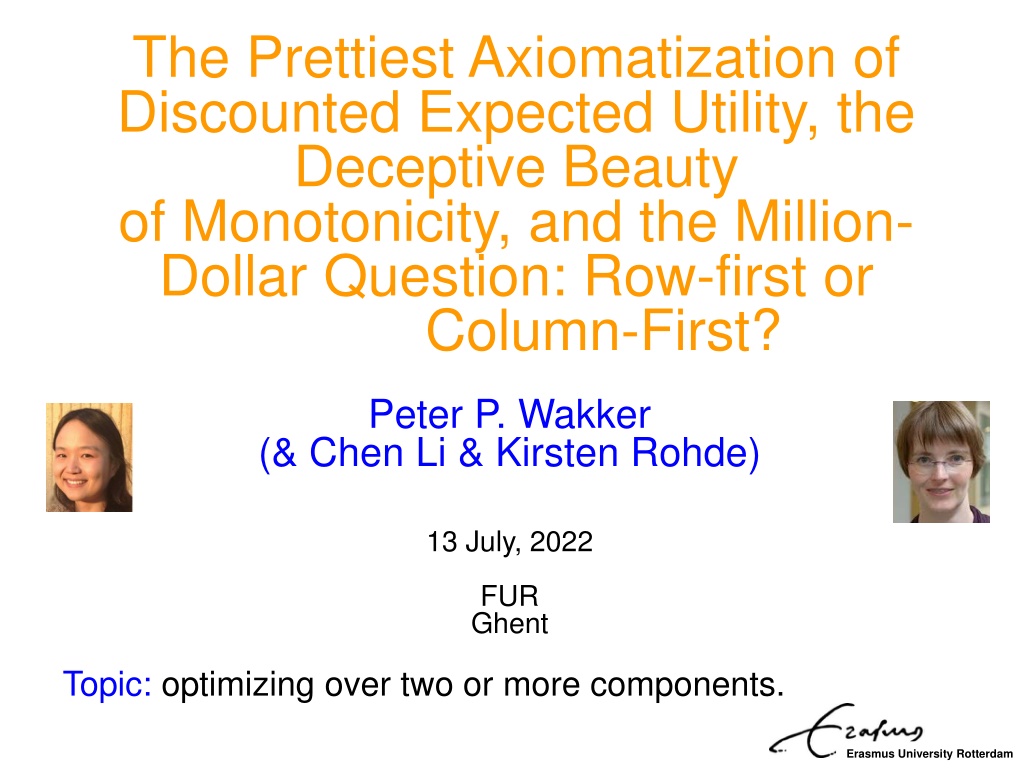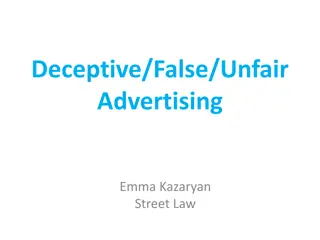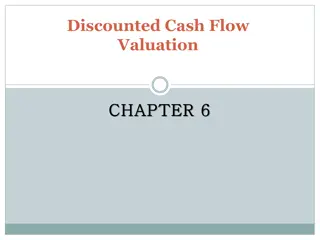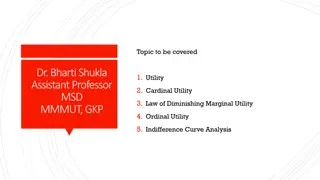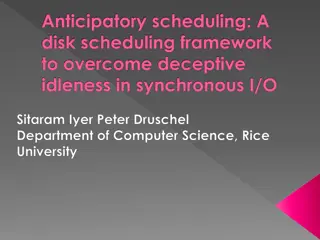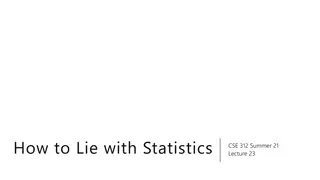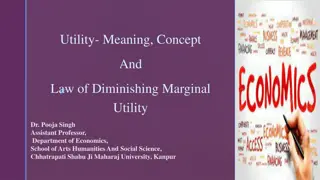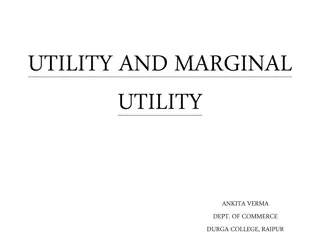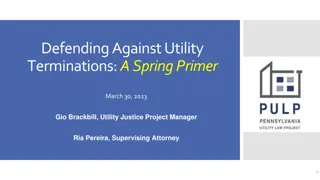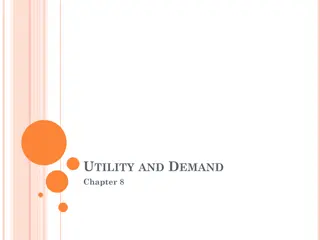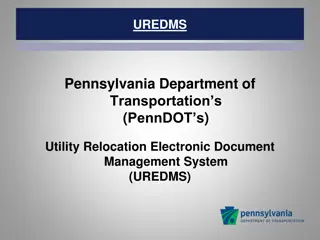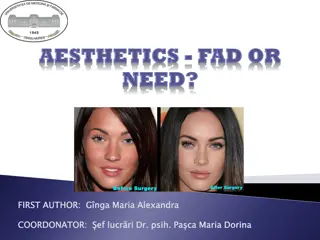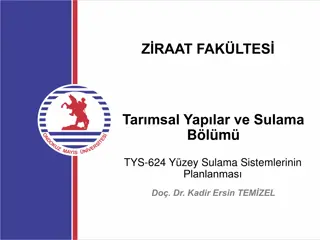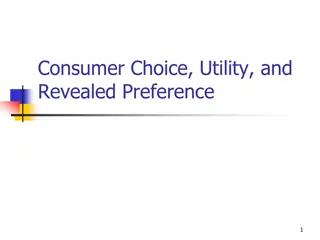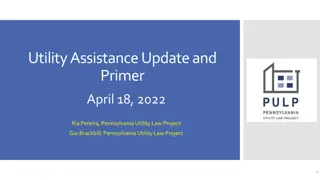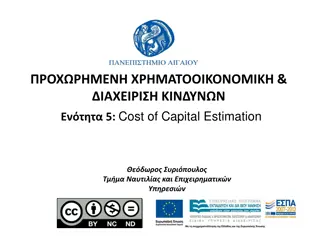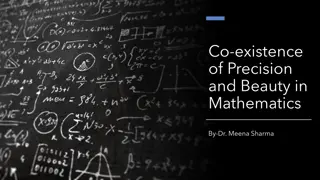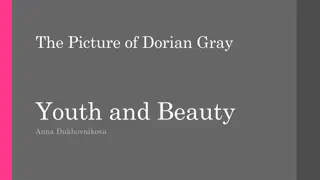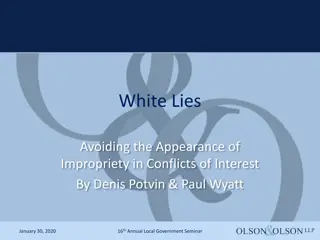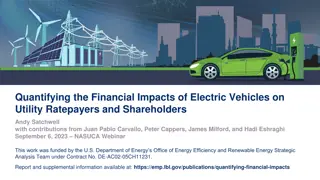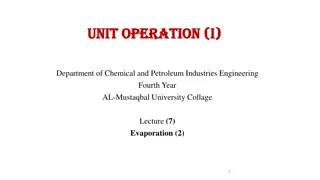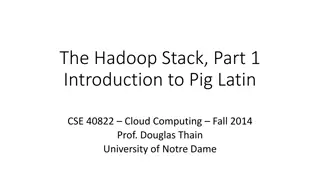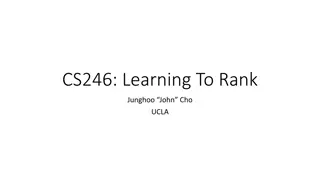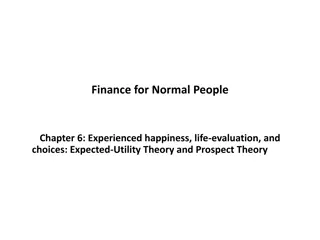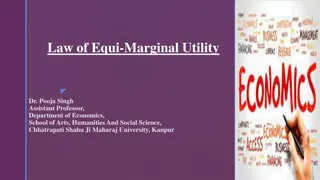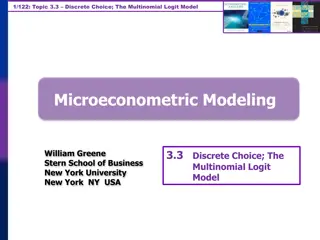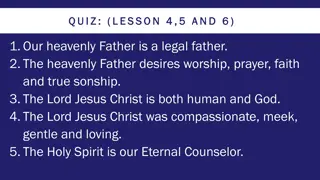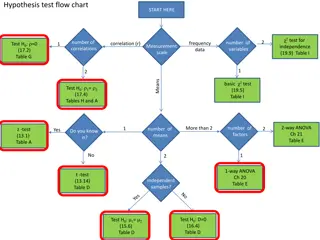The Deceptive Beauty of Discounted Expected Utility: A Study on Optimizing Over Multiple Components
This study delves into the intricate world of discounted expected utility, exploring various axioms, generalizations, variations, and applications. It questions the row-first versus column-first approach and discusses preferences over outcome streams and lotteries. The investigation leads to profound insights on monotonicity and the optimization of time and risk jointly.
Download Presentation

Please find below an Image/Link to download the presentation.
The content on the website is provided AS IS for your information and personal use only. It may not be sold, licensed, or shared on other websites without obtaining consent from the author. Download presentation by click this link. If you encounter any issues during the download, it is possible that the publisher has removed the file from their server.
E N D
Presentation Transcript
The Prettiest Axiomatization of Discounted Expected Utility, the Deceptive Beauty of Monotonicity, and the Million- Dollar Question: Row-first or Column-First? Peter P. Wakker (& Chen Li & Kirsten Rohde) 13 July, 2022 FUR Ghent Topic: optimizing over two or more components. Erasmus University Rotterdam
Outline 1. Axiomatization of DEU 1.1. The most-falsified model ever 1.2. The standard (nonobjectionable) axioms 1.3. The critical (objectionable!) axioms 1.4. A paradoxical theorem 2. Generalizations 2.1. Digression on separability (only 1 component) 2.2. Separability for two components 2.3. A shocking theorem 3. Variation & Remedies 3.1. Trouble for recursive formulas; bifurcation 3.2. Examples 3.3. Diagnoses & remedies 4. Applications 2
Nowadays: many studies into time & risk jointly. ?1 . . .?12 . . . ?12 1 1 ?1 . . . ?6 ?1 . . . Each ?? has probability 1/6 (DUR) . . . 6 . . . ?12 6 ?1 ? Each ?? Called risky outcome stream. Preferences over these: on 6 12 3
Outcome stream (?1,,?12) identified with ?1 . . . ?12 ?1 . . . ?12 . . . ?1 . . . ?6 . . . ?1 . . . ?12 Preferences over outcome streams: on 12 4
Lottery (?1,,?6) identified with ?1 . . . ?12 ?10 . . 0 . . . . ?1 . . . ?6 . . . . . ?60 . . 0 Preferences over lotteries: on 6 5
Discounted expected utility: 1 6 12 6 ?) ???(?? ?=1 ?=1 (all ??> 0; ? cont. & str. increasing) Most-falsified model ever! > < > < > < Expected utility for risk: Discounted utility: Same ? for risk & time: 6
Outline 1. Axiomatization of DEU 1.1. The most-falsified model ever 1.2. The standard (nonobjectionable) axioms 1.3. The critical (objectionable!) axioms 1.4. A paradoxical theorem 2. Generalizations 2.1. Digression on separability (only 1 component) 2.2. Separability for two components 2.3. A shocking theorem 3. Variation & Remedies 3.1. Trouble for recursive formulas; bifurcation 3.2. Examples 3.3. Diagnoses & remedies 4. Applications 7
1. weak ordering; 2. continuity; 3. outcome monotonicity; 4. lottery monotonicity; 5. stream monotonicity. 8
Outline 1. Axiomatization of DEU 1.1. The most-falsified model ever 1.2. The standard (nonobjectionable) axioms 1.3. The critical (objectionable!) axioms 1.4. A paradoxical theorem 2. Generalizations 2.1. Digression on separability (only 1 component) 2.2. Separability for two components 2.3. A shocking theorem 3. Variation & Remedies 3.1. Trouble for recursive formulas; bifurcation 3.2. Examples 3.3. Diagnoses & remedies 4. Applications 9
Outline 1. Axiomatization of DEU 1.1. The most-falsified model ever 1.2. The standard (nonobjectionable) axioms 1.3. The critical (objectionable!) axioms 1.4. A paradoxical theorem 2. Generalizations 2.1. Digression on separability (only 1 component) 2.2. Separability for two components 2.3. A shocking theorem 3. Variation & Remedies 3.1. Trouble for recursive formulas; bifurcation 3.2. Examples 3.3. Diagnoses & remedies 4. Applications 11
Theorem 1. Equivalent are: i. Discounted expected utility holds. ii. - Weak ordering, - continuity, - outcome monotonicity, - stream monotonicity, - lottery monotonicity. More general (but less pretty): Mongin & Pivato (2015) 12
Outline 1. Axiomatization of DEU 1.1. The most-falsified model ever 1.2. The standard (nonobjectionable) axioms 1.3. The critical (objectionable!) axioms 1.4. A paradoxical theorem 2. Generalizations 2.1. Digression on separability (only 1 component) 2.2. Separability for two components 2.3. A shocking theorem 3. Variation & Remedies 3.1. Trouble for recursive formulas; bifurcation 3.2. Examples 3.3. Diagnoses & remedies 4. Applications 13
Outline 1. Axiomatization of DEU 1.1. The most-falsified model ever 1.2. The standard (nonobjectionable) axioms 1.3. The critical (objectionable!) axioms 1.4. A paradoxical theorem 2. Generalizations 2.1. Digression on separability (only 1 component) 2.2. Separability for two components 2.3. A shocking theorem 3. Variation & Remedies 3.1. Trouble for recursive formulas; bifurcation 3.2. Examples 3.3. Diagnoses & remedies 4. Applications 14
Consumer theory/multiattribute utility ?1, ,??: ? attributes : over ?-tuples; transitive, complete, continuous, monotonic. {??,??} separable: ??,??,?3, ,?? ??,??,?3, ,?? ??,??,?3, ,?? ??,??,?3, ,?? Complete separability: all subgroups of attributes are separable; no interactions between attributes. 15
Weak separability: each single attribute is separable. ?1, ,?? 1,??,??+1, ,?? ?1, ,?? 1,??,??+1, ,?? ?1, ,?? 1,??,??+1, ,?? ?1, ,?? 1,??, ??+1, ,?? Implied by monotonicity; so, weak!? 16
Behavioral models operate in middle ground. weak separability satisfied; complete separability not, so, there are interactions. Middle ground: 17
Middle- ground; (interactions; behavioral) Weak separability Stoch. dominance Complete separability EU 79 OPT Edwards 55, Handa 78 Non-EU (RDU, 92 PT, DA, ) Fairness; sequencing effects 18
Outline 1. Axiomatization of DEU 1.1. The most-falsified model ever 1.2. The standard (nonobjectionable) axioms 1.3. The critical (objectionable!) axioms 1.4. A paradoxical theorem 2. Generalizations 2.1. Digression on separability (only 1 component) 2.2. Separability for two components 2.3. A shocking theorem 3. Variation & Remedies 3.1. Trouble for recursive formulas; bifurcation 3.2. Examples 3.3. Diagnoses & remedies 4. Applications 19
Our general approach: components can be just anything. 2 1 1 1?2 1?3 1?4 1?5 ?1 1 1 1 0 2 2?2 2?3 2?4 2?5 ?1 0 0 1 0 3 3?2 4?2 3?3 4?3 3?4 4?4 3?5 4?5 ?1 ?1 4 20
?1 . . . ?? 1 . . . ?? 1 ?1 . . . ?1 . . . . . . ?. . . ?? ? ?? ?1 ? Each ?? Called matrix. Is ? ? product of cells. Attributes are cells. Can also take it as: ?-fold product of rows (?-tuples). Attributes are rows. Or: ?-fold product of columns (?-tuples). Attributes are columns. 21
Weak separability for rows-product: every single row is separable (row-monotonicity). Weak separability for columns-product: every single column is separable (column-monotonicity). Complete separabilities: similar. Middle ground: the two weak separabilities hold, but the two complete separabilities do not. 22
Outline 1. Axiomatization of DEU 1.1. The most-falsified model ever 1.2. The standard (nonobjectionable) axioms 1.3. The critical (objectionable!) axioms 1.4. A paradoxical theorem 2. Generalizations 2.1. Digression on separability (only 1 component) 2.2. Separability for two components 2.3. A shocking theorem 3. Variation & Remedies 3.1. Trouble for recursive formulas; bifurcation 3.2. Examples 3.3. Diagnoses & remedies 4. Applications 23
Row- and column monotonicity (hold your heart ) Complete row- and column separability Complete cell-separability (no interactions) Additive utility, ?? ?(?? ?), holds. When discovered? 24
1948! Nataf, Andr (1948) Sur la Possibilit de Construction de Certain Macromod les, Econometrica 16, 232 244. He considered macro-micro aggregation of production processes: 1 1?2 1?3 1?4 1?5 ?1 2 2?2 2?3 2?4 2?5 ?1 3 3?2 4?2 3?3 4?3 3?4 4?4 3?5 4?5 ?1 ?1 4 25
Nataf explains paradox of DEU theorem. ?1 . . . ?12 . . . ?12 1 1 ?1 . . . ?6 ?1 . . . . . . 6 . . . ?12 6 ?1 Monotonicity is deceptive. Nataf has enormous further implications. (no middle ground ). 26
Outline 1. Axiomatization of DEU 1.1. The most-falsified model ever 1.2. The standard (nonobjectionable) axioms 1.3. The critical (objectionable!) axioms 1.4. A paradoxical theorem 2. Generalizations 2.1. Digression on separability (only 1 component) 2.2. Separability for two components 2.3. A shocking theorem 3. Variation & Remedies 3.1. Trouble for recursive formulas; bifurcation 3.2. Examples 3.3. Diagnoses & remedies 4. Applications 27
Outline 1. Axiomatization of DEU 1.1. The most-falsified model ever 1.2. The standard (nonobjectionable) axioms 1.3. The critical (objectionable!) axioms 1.4. A paradoxical theorem 2. Generalizations 2.1. Digression on separability (only 1 component) 2.2. Separability for two components 2.3. A shocking theorem 3. Variation & Remedies 3.1. Trouble for recursive formulas; bifurcation 3.2. Examples 3.3. Diagnoses & remedies 4. Applications 28
Recursive evaluation, row-first: ?1 . . . ?? ?1 . . . . 1 . . . ?? 1 1, ,?? 2, ,?? 1 1 = ?1 = ?2 ?1 . . ? ?1 ?2?1 . . . . . . 2 . . . ?. . . ?? ? ?, ,?? ?? ???1 ?= ?? ?1 ?(?1, ,??) All str. increasing & continuous. Implies row-monotonicity! Column-first: analogous; implies column-monotonicity. 29
Behavioral: interactions. Tractable recursive. ... . . . ... Complete separability = Weak separability Bifurcation! 30
Outline 1. Axiomatization of DEU 1.1. The most-falsified model ever 1.2. The standard (nonobjectionable) axioms 1.3. The critical (objectionable!) axioms 1.4. A paradoxical theorem 2. Generalizations 2.1. Digression on separability (only 1 component) 2.2. Separability for two components 2.3. A shocking theorem 3. Variation & Remedies 3.1. Trouble for recursive formulas; bifurcation 3.2. Examples 3.3. Diagnoses & remedies 4. Applications 31
1 1 1 0 0 0 1 0 Column-monotonic: all is fair. Row-monotonic: right fair, left unfair. 32
2 2 1 1 1 1 1 0 0 0 1 0 Column-monotonic: all is unambiguous. Row-monotonic: right unambiguous; left ambiguous. 33
Outline 1. Axiomatization of DEU 1.1. The most-falsified model ever 1.2. The standard (nonobjectionable) axioms 1.3. The critical (objectionable!) axioms 1.4. A paradoxical theorem 2. Generalizations 2.1. Digression on separability (only 1 component) 2.2. Separability for two components 2.3. A shocking theorem 3. Variation & Remedies 3.1. Trouble for recursive formulas; bifurcation 3.2. Examples 3.3. Diagnoses & remedies 4. Applications 34
Diagnosis on $million question (separability): risk > ambiguity > welfare > intertemporal > attributes 35
The framing diagnosis/remedy: ?1 . . .?12 . . . ?12 1 1 ?1 . . . ?6 ?1 . . . . . . 6 . . . ?12 6 ?1 ?, ,?? At each state ?? you receive outcome stream (?1 state (row)-monotonicity ?) ?1 1 ?1 ?1 . . . . . . 1 ?? . ?? . . . state (row)-monotonicity . ?1 ? ?1 . . . . . . . ?? ? ?? ?? 36
Timing remedy Partial-info remedy 37
Outline 1. Axiomatization of DEU 1.1. The most-falsified model ever 1.2. The standard (nonobjectionable) axioms 1.3. The critical (objectionable!) axioms 1.4. A paradoxical theorem 2. Generalizations 2.1. Digression on separability (only 1 component) 2.2. Separability for two components 2.3. A shocking theorem 3. Variation & Remedies 3.1. Trouble for recursive formulas; bifurcation 3.2. Examples 3.3. Diagnoses & remedies 4. Applications 38
Random incentive system, illustrated by hedging under ambiguity Fair coin will be flipped: Heads or Tails? Ball from ambiguous urn: Black or Red? Ambiguous urn A ? 100 ? 100 R&B in unknown proportion 39
Experiment Choice situation ?1: ?:101 (?:100) Choice situation ?2: ?:101 ?:100 RIS: one choice situation randomly chosen and implemented. Can we conclude that no, or very little, ambiguity aversion? Many argue that not, due to confounding hedging : 40
?? ?? ?? ?? 101 ?? ?? ?? ?? 100 ?1 ?1 0 101 0 0 0 100 ?2 ?2 0 101 0 101 0 0 100 100 41
Other discussions amounting to our million-dollar question and its remedies: - RIS in general - Equality in welfare: ex-ante vs. ex-post fairness (Harsanyi ) - Correlation-preference in intertemporal choice - Multivariate risk aversion - Monotonicity in Anscombe-Aumann framework - Monotonicity in smooth model of ambiguity 42
Conclusion Watch out for monotonicity! 43
